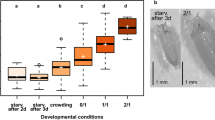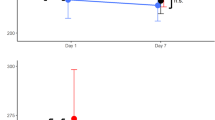Summary
Heat and CO2rates are measured on M. domesticapupae as a function of age and temperature. Heats of combustion of flies, pupae, and puparia are also measured. Heat and CO2rates decrease for 3 d post-pupation and increase exponentially over 4 d prior to eclosure. Heat and CO2rates are low and increase slowly from 5 to 23°C, then rapidly increase from 23 to 26°C, then more slowly up to 38°C where pupae are stressed. Respiratory substrate varies with age and temperature, is a mix of lipids and carbohydrates, and has an average carbon oxidation state of -0.3 at room temperature. Humidity, elevated CO2, or reduced O2did not affect pupal metabolism.
Similar content being viewed by others
Author information
Authors and Affiliations
Rights and permissions
About this article
Cite this article
Joyal, J., Hansen, L., Coons, D. et al. Calorespirometric determination of the effects of temperature, humidity, low O2and high CO2on the development of Musca domesticapupae. J Therm Anal Calorim 82, 703–709 (2005). https://doi.org/10.1007/s10973-005-0953-6
Issue Date:
DOI: https://doi.org/10.1007/s10973-005-0953-6




